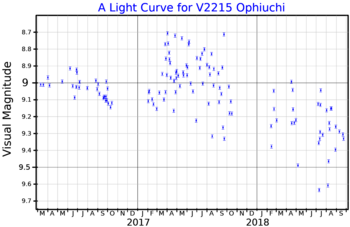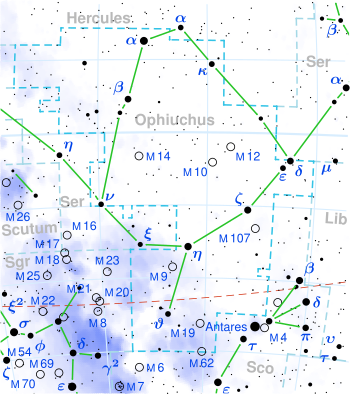| This article needs additional citations for verification. Please help improve this article by adding citations to reliable sources. Unsourced material may be challenged and removed. Find sources: "36 Ophiuchi" – news · newspapers · books · scholar · JSTOR (January 2021) (Learn how and when to remove this message) |
 A visual band light curve for 36 Ophiuchi C (V2215 Ophiuchi), plotted from ASAS-SN data | |
| Observation data Epoch J2000 Equinox J2000 | |
|---|---|
| Constellation | Ophiuchus |
| Right ascension | A: 17 15 20.851 B: 17 15 20.978 C: 17 16 13.3624 |
| Declination | A: −26° 36′ 09.04″ B: −26° 36′ 10.18″ C: −26° 32′ 46.129″ |
| Apparent magnitude (V) | 5.08/5.03/6.34 |
| Characteristics | |
| Spectral type | K2 V/K1 V/K5 V |
| U−B color index | 0.51(AB)/1.04 |
| B−V color index | 0.85(AB)/1.16 |
| Variable type | C: RS CVn |
| Astrometry | |
| 36 Oph A | |
| Radial velocity (Rv) | −0.6 km/s |
| Proper motion (μ) | RA: −498.600±0.123 mas/yr Dec.: −1149.158±0.086 mas/yr |
| Parallax (π) | 168.0031 ± 0.1343 mas |
| Distance | 19.41 ± 0.02 ly (5.952 ± 0.005 pc) |
| 36 Oph B | |
| Radial velocity (Rv) | 0.0 km/s |
| Proper motion (μ) | RA: −465.861±0.111 mas/yr Dec.: −1141.168±0.073 mas/yr |
| Parallax (π) | 168.1303 ± 0.1081 mas |
| Distance | 19.40 ± 0.01 ly (5.948 ± 0.004 pc) |
| 36 Oph C | |
| Radial velocity (Rv) | −0.04±0.22 km/s |
| Proper motion (μ) | RA: −479.573±0.031 mas/yr Dec.: −1124.332±0.020 mas/yr |
| Parallax (π) | 167.9617 ± 0.0311 mas |
| Distance | 19.418 ± 0.004 ly (5.954 ± 0.001 pc) |
| Orbit | |
| Companion | 36 Ophiuchi B |
| Period (P) | 568.9 yr |
| Semi-major axis (a) | 14.7″ |
| Eccentricity (e) | 0.922 |
| Inclination (i) | 99.6° |
| Longitude of the node (Ω) | −83.6° |
| Periastron epoch (T) | 1,763.39 |
| Details | |
| 36 Oph A | |
| Radius | 0.817 ± 0.016 R☉ |
| Temperature | 4,843 ± 134 K |
| Metallicity | –0.20 dex |
| Age | 0.6-1.8 Gyr |
| B | |
| Temperature | 4,985 ± 20 K |
| Metallicity | –0.31 ± 0.042 dex |
| Other designations | |
| 36 Oph, WDS J17153-2636 | |
| AB: GJ 663, CD−26°12026, GCTP 3908.00, HIP 84405 | |
| A: Guniibuu, HR 6402, HD 155886, LHS 437, SAO 185198 | |
| B: HR 6401, HD 155885, LHS 438, SAO 185199 | |
| C: V2215 Ophiuchi, GJ 664, CD−26°12036, HD 156026, GCTP 3913.00, LHS 439, SAO 185213, HIP 84478 | |
| Database references | |
| SIMBAD | AB |
| A | |
| B | |
| C | |
| Exoplanet Archive | A |
| B | |
| C | |
| ARICNS | A |
| B | |
| C | |
 | |
36 Ophiuchi (or Guniibuu for component A) is a triple star system 19.5 light-years from Earth. It is in the constellation Ophiuchus.
The primary and secondary stars (also known as HD 155886) are nearly identical orange main-sequence dwarfs of spectral type K2/K1. This binary is unusual because its eruptions do not seem to conform to the Waldmeier effect; that is, the strongest eruptions of HD 155886 are not the ones characterized by the fast eruption onset. The tertiary star is an orange main-sequence dwarf of spectral type K5.
Star C is separated from the A-B pair by 700 arcseconds, compared to a minimum of 4.6 arcseconds for A-B, so its effect on the movements of the A-B pair is small. A and B have active chromospheres. At present the distance between the stars forming the AB-pair is 5.1 arcseconds and the position angle is 139 degrees, while star C is 731.6 arcseconds away from the A-component and situated at a position angle of 74 degrees.
Nomenclature
In the beliefs of the Kamilaroi and Euahlayi Aboriginal peoples in New South Wales, Australia, the star is called Guniibuu that represents the robin red-breast bird (Petroica boodang). In 2016, the IAU organized a Working Group on Star Names (WGSN) to catalog and standardize proper names for stars. The WGSN approved the name Guniibuu for the star A on 10 August 2018 and it is now so included in the List of IAU-approved Star Names.
Hunt for substellar objects
The McDonald Observatory team has set limits to the presence of one or more planets around 36 Ophiuchi A with masses between 0.13 and 5.4 Jupiter masses and average separations spanning between 0.05 and 5.2 astronomical units (AU), although beyond 1.5 AU orbits are inherently unstable around either 36 Ophiuchi A or 36 Ophiuchi B.
The star C (or namely HD 156026) is among five nearby paradigms as K-type stars of a type in a 'sweet spot’ between Sun-analog stars and M stars for the likelihood of evolved life, per analysis of Giada Arney from NASA's Goddard Space Flight Center.
Notes
References
- ^ "ASAS-SN Variable Stars Database". ASAS-SN Variable Stars Database. ASAS-SN. Retrieved 6 January 2022.
- ^ "SIMBAD Astronomical Database". Centre de Données astronomiques de Strasbourg. Retrieved 2013-08-23.
- ^ Brown, A. G. A.; et al. (Gaia collaboration) (2021). "Gaia Early Data Release 3: Summary of the contents and survey properties". Astronomy & Astrophysics. 649: A1. arXiv:2012.01533. Bibcode:2021A&A...649A...1G. doi:10.1051/0004-6361/202039657. S2CID 227254300. (Erratum: doi:10.1051/0004-6361/202039657e). Gaia EDR3 record for this source at VizieR.
- ^ Brown, A. G. A.; et al. (Gaia collaboration) (2021). "Gaia Early Data Release 3: Summary of the contents and survey properties". Astronomy & Astrophysics. 649: A1. arXiv:2012.01533. Bibcode:2021A&A...649A...1G. doi:10.1051/0004-6361/202039657. S2CID 227254300. (Erratum: doi:10.1051/0004-6361/202039657e). Gaia EDR3 record for this source at VizieR.
- ^ Brown, A. G. A.; et al. (Gaia collaboration) (2021). "Gaia Early Data Release 3: Summary of the contents and survey properties". Astronomy & Astrophysics. 649: A1. arXiv:2012.01533. Bibcode:2021A&A...649A...1G. doi:10.1051/0004-6361/202039657. S2CID 227254300. (Erratum: doi:10.1051/0004-6361/202039657e). Gaia EDR3 record for this source at VizieR.
- ^ Demory, Brice-Olivier; Ségransan, Damien; Forveille, Thierry; Queloz, Didier; Beuzit, Jean-Luc; Delfosse, Xavier; Di Folco, Emmanuel; Kervella, Pierre; Le Bouquin, Jean-Baptiste; Perrier, Christian; Benisty, Myriam; Duvert, Gilles; Hofmann, Karl-Heinz; Lopez, Bruno; Petrov, Romain (October 2009). "Mass-radius relation of low and very low-mass stars revisited with the VLTI". Astronomy and Astrophysics. 505 (1): 205–215. arXiv:0906.0602. Bibcode:2009A&A...505..205D. doi:10.1051/0004-6361/200911976. S2CID 14786643.
- ^ Wittenmeyer et al. (2006).
- Mamajek, Eric E.; Hillenbrand, Lynne A. (November 2008), "Improved Age Estimation for Solar-Type Dwarfs Using Activity-Rotation Diagnostics", The Astrophysical Journal, 687 (2): 1264–1293, arXiv:0807.1686, Bibcode:2008ApJ...687.1264M, doi:10.1086/591785, S2CID 27151456
- ^ Taylor, B. J. (December 2005), "Statistical Cataloging of Archival Data for Luminosity Class IV-V Stars. III. The Epoch 2004 and Temperature Catalogs", The Astrophysical Journal Supplement Series, 161 (2): 444–455, Bibcode:2005ApJS..161..444T, doi:10.1086/496885.Vizier catalog entry
- Garg, Suyog; Karak, Bidya Binay; Egeland, Ricky; Soon, Willie; Baliunas, Sallie (2019), "Waldmeier Effect in Stellar Cycles", The Astrophysical Journal, 886 (2): 132, arXiv:1909.12148, Bibcode:2019ApJ...886..132G, doi:10.3847/1538-4357/ab4a17, S2CID 202888617
- "IAU Working Group on Star Names (WGSN)". Retrieved 17 September 2018.
- "IAU Catalog of Star Names". International Astronomical Union. Retrieved 2018-09-17.
- Irwin et al. (1996).
-
Bill Steigerwald (2019-03-07). ""Goldilocks" Stars May Be "Just Right" for Finding Habitable Worlds". NASA. Retrieved 2020-05-12.
'I find that certain nearby K stars like 61 Cyg A/B, Epsilon Indi, Groombridge 1618, and HD 156026 may be particularly good targets for future biosignature searches,' said Arney.
Further reading
- Irwin, Alan W.; Yang, Stephenson L. S. & Walker, Gordon A. H. (1996), "36 Ophiuchi AB: Incompatibility of the Orbit and Precise Radial Velocities", Publications of the Astronomical Society of the Pacific, 108: 580, Bibcode:1996PASP..108..580I, doi:10.1086/133768
- Cayrel de Strobel, G.; Lebreton, Y.; Perrin, M.-N. & Cayrel, R. (1989), "A thorough spectroscopic study of the very nearby triple system - 36 Ophiuchi", Astronomy and Astrophysics, 225 (2): 369–380, Bibcode:1989A&A...225..369C
- Wittenmeyer, R. A.; Endl, Michael; Cochran, William D.; Hatzes, Artie P.; Walker, G. A. H.; Yang, S. L. S. & Paulson, Diane B. (2006), "Detection Limits from the McDonald Observatory Planet Search Program", Astronomical Journal, 132 (1): 177–188, arXiv:astro-ph/0604171, Bibcode:2006AJ....132..177W, doi:10.1086/504942, S2CID 16755455
- Barnes, Sydney A. (2007), "Ages for Illustrative Field Stars Using Gyrochronology: Viability, Limitations, and Errors", The Astrophysical Journal, 669 (2): 1167–1189, arXiv:0704.3068, Bibcode:2007ApJ...669.1167B, doi:10.1086/519295, S2CID 14614725
External links
- "36 Ophiuchi". SolStation. Retrieved 3 November 2005.
- https://arxiv.org/abs/astro-ph/0604171
| Known celestial objects within 20 light-years | |||||||||||||||||||||||||||||||||||||||||||
|---|---|---|---|---|---|---|---|---|---|---|---|---|---|---|---|---|---|---|---|---|---|---|---|---|---|---|---|---|---|---|---|---|---|---|---|---|---|---|---|---|---|---|---|
| |||||||||||||||||||||||||||||||||||||||||||
| |||||||||||||||||||||||||||||||||||||||||||
| |||||||||||||||||||||||||||||||||||||||||||
| |||||||||||||||||||||||||||||||||||||||||||
| Italic are systems without known trigonometric parallax. | |||||||||||||||||||||||||||||||||||||||||||
- Ophiuchus
- Triple star systems
- Flamsteed objects
- K-type main-sequence stars
- Solar-type stars
- Bright Star Catalogue objects
- Henry Draper Catalogue objects
- Hipparcos objects
- Durchmusterung objects
- Bayer objects
- RS Canum Venaticorum variables
- Gliese and GJ objects
- Objects with variable star designations
- Stars with proper names